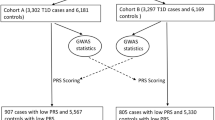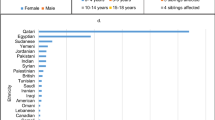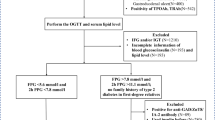Abstract
Aims
Recent meta-genome-wide association studies identified several genetic variants associated with beta-cell function in type 1 diabetes (T1D). The aim of this study was to investigate the associations between these variants and T1D risk, C-peptide levels, islet-specific autoantibodies, and lipid levels in Chinese Han population.
Methods
A total of 1005 unrelated autoantibody-positive T1D cases and 1417 healthy controls were included, which were genotyped for rs559047, rs9260151, and rs3135002. T1D individuals were measured for both C-peptide and lipid levels. Logistic regression models were used to examine these associations.
Results
We found that rs3135002 A allele showed a genome-wide significant association with T1D risk (OR = 0.22, 95% CI = 0.17–0.30; P = 7.49 × 10−27), and significant heterogeneity of effect size was observed between early-onset and later-onset T1D subgroups (I2 = 80% and P = 0.026). Rs559047 had a nominal association with fasting C-peptide levels in newly diagnosed T1D individuals (P = 0.036). Moreover, rs3135002 A allele was significantly associated with GADA positivity (OR = 0.52, 95% CI = 0.30–0.91, P = 0.02). In addition, nominal correlations were observed with HDL levels for rs559047 (P = 0.042), while LDL levels for rs9260151 (P = 0.032) in T1D individuals.
Conclusions
Our results indicate that there are both similarities and differences for the associations of genetic variants among T1D development, progression, and related autoimmunity, metabolic traits.
This is a preview of subscription content, access via your institution
Access options
Subscribe to this journal
Receive 12 print issues and online access
$259.00 per year
only $21.58 per issue
Buy this article
- Purchase on Springer Link
- Instant access to full article PDF
Prices may be subject to local taxes which are calculated during checkout
Similar content being viewed by others

References
Wållberg M, Cooke A. Immune mechanisms in type 1 diabetes. Trends Immunol. 2013;34:583–91.
Katsarou A, Gudbjörnsdottir S, Rawshani A, Dabelea D, Bonifacio E, Anderson BJ, et al. Type 1 diabetes mellitus. Nat Rev Dis Prim. 2017;30:1701–16.
Pociot F, Lernmark Å. Genetic risk factors for type 1 diabetes. Lancet. 2016;387:2331–9.
Rewers M, Ludvigsson J. Environmental risk factors for type 1 diabetes. Lancet. 2016;387:2340–8.
Zhu M, Xu K, Chen Y, Gu Y, Zhang M, Luo F, et al. Identification of novel T1D risk loci and their association with age and islet function at diagnosis in autoantibody-positive T1D individuals: based on a two-stage genome-wide association study. Diabetes Care. 2019;42:1414–21.
Plagnol V, Howson JM, Smyth DJ, Walker N, Hafler JP, Wallace C, et al. Genome-wide association analysis of autoantibody positivity in type 1 diabetes cases. PLoS Genet. 2011;7:e1002216.
Howson JM, Krause S, Stevens H, Smyth DJ, Wenzlau JM, Bonifacio E, et al. Genetic association of zinc transporter 8 (ZnT8) autoantibodies in type 1 diabetes cases. Diabetologia. 2012;55:1978–84.
Palmer JP, Fleming GA, Greenbaum CJ, Herold KC, Jansa LD, Kolb H, et al. C-peptide is the appropriate outcome measure for type 1 diabetes clinical trials to preserve beta-cell function: report of an ADA workshop, 21–22 October 2001. Diabetes. 2004;53:250–64.
Lachin JM, McGee P, Palmer JP.DCCT/EDIC Research Group Impact of C-peptide preservation on metabolic and clinical outcomes in the diabetes control and complications trial. Diabetes. 2014;63:739–48.
Keenan HA, Sun JK, Levine J, Doria A, Aiello LP, Eisenbarth G, et al. Residual insulin production and pancreatic ß-Cell turnover after 50 years of diabetes: Joslin medalist study. Diabetes. 2010;59:2846–53.
Wang L, Lovejoy NF, Faustman DL. Persistence of prolonged C-peptide production in type 1 diabetes as measured with an ultrasensitive C-peptide assay. Diabetes Care. 2012;35:465–70.
Oram RA, Jones AG, Besser RE, Knight BA, Shields BM, Brown RJ, et al. The majority of patients with long-duration type 1 diabetes are insulin microsecretors and have functioning beta cells. Diabetologia. 2014;57:187–91.
Roshandel D, Gubitosi-Klug R, Bull SB, Canty AJ, Pezzolesi MG, King GL, et al. Meta-genome-wide association studies identify a locus on chromosome 1 and multiple variants in the MHC region for serum C-peptide in type 1 diabetes. Diabetologia. 2018;61:1098–11.
Petrone A, Spoletini M, Zampetti S, Capizzi M, Zavarella S, Osborn J, et al. The PTPN22 1858T gene variant in type 1 diabetes is associated with reduced residual beta-cell function and worse metabolic control. Diabetes Care. 2008;31:1214–8.
Lempainen J, Laine AP, Hammais A, Toppari J, Simell O, Veijola R, et al. Non-HLA gene effects on the disease process of type 1 diabetes: from HLA susceptibility to overt disease. J Autoimmun. 2015;61:45–53.
Fourlanos S, Dotta F, Greenbaum CJ, Palmer JP, Rolandsson O, Colman PG, et al. Latent autoimmune diabetes in adults (LADA) should be less latent. Diabetologia. 2005;48:2206–12.
Davis AK, DuBose SN, Haller MJ, Miller KM, DiMeglio LA, Bethin KE, et al. Prevalence of detectable C-Peptide according to age at diagnosis and duration of type 1 diabetes. Diabetes Care. 2015;38:476–81.
Hao W, Gitelman S, DiMeglio LA, Boulware D, Greenbaum CJ.Type 1 Diabetes TrialNet Study Group Fall in C-peptide during first 4 years from diagnosis of type 1 diabetes: variable relation to age, HbA1c, and insulin dose. Diabetes Care. 2016;39:1664–70.
Juusola M, Parkkola A, Härkönen T, Siljander H, Ilonen J, Åkerblom HK, et al. Positivity for zinc transporter 8 autoantibodies at diagnosis is subsequently associated with reduced β-cell function and higher exogenous insulin requirement in children and adolescents with type 1 diabetes. Diabetes Care 2016;39:118–21.
Weng J, Zhou Z, Guo L, Zhu D, Ji L, Luo X, et al. Incidence of type 1 diabetes in China, 2010-13: population based study. Brit Med J. 2018;3:j5295.
Howson JM, Rosinger S, Smyth DJ, Boehm BO, Todd JA. ADBW-END Study Group Genetic analysis of adult-onset autoimmune diabetes. Diabetes. 2011;60:2645–53.
Howson JM, Cooper JD, Smyth DJ, Walker NM, Stevens H, She JX, et al. Evidence of gene-gene interaction and age-at-diagnosis effects in type 1 diabetes. Diabetes. 2012;61:3012–7.
Liley J, Todd JA, Wallace C. A method for identifying genetic heterogeneity within phenotypically defined disease subgroups. Nat Genet. 2017;49:310–6.
McKeigue PM, Spiliopoulou A, McGurnaghan S, Colombo M, Blackbourn L, McDonald TJ, et al. Persistent C-peptide secretion in Type 1 diabetes and its relationship to the genetic architecture of diabetes. BMC Med. 2019;17:165.
Nakanishi K, Inoko H. Combination of HLA-A24, -DQA1*03, and -DR9 contributes to acute-onset and early complete beta-cell destruction in type 1 diabetes: longitudinal study of residual beta-cell function. Diabetes. 2006;55:1862–8.
Barker A, Lauria A, Schloot N, Hosszufalusi N, Ludvigsson J, Mathieu C, et al. Age-dependent decline of β-cell function in type 1 diabetes after diagnosis: a multi-centre longitudinal study. Diabetes Obes Metab. 2014;16:262–7.
Sherr JL, Ghazi T, Wurtz A, Rink L, Herold KC. Characterization of residual β cell function in long-standing type 1 diabetes. Diabetes Metab Res Rev. 2014;30:154–62.
Hermann R, Lipponen K, Kiviniemi M, Kakko T, Veijola R, Simell O, et al. Lymphoid tyrosine phosphatase (LYP/PTPN22) Arg620Trp variant regulates insulin autoimmunity and progression to type 1 diabetes. Diabetologia. 2006;49:1198–208.
Brorsson CA, Pociot F. Type 1 diabetes genetics consortium. shared genetic basis for Type 1 diabetes, islet autoantibodies, and autoantibodies associated with other immune-mediated diseases in families with Type 1 diabetes. Diabetes Care. 2015;38(Suppl 2):S8–13.
Vergès B. Lipid disorders in type 1 diabetes. Diabetes Metab. 2009;35:353–60.
Słomiński B, Ławrynowicz U, Ryba-Stanisławowska M, Skrzypkowska M, Myśliwska J, Myśliwiec M. CCR5-Δ32 polymorphism is a genetic risk factor associated with dyslipidemia in patients with type 1 diabetes. Cytokine. 2019;114:81–5.
Tracz A, Madzio J, Gnys P, Malachowska B, Borowiec M, Wyka K, et al. Genetic variability of GCKR alters lipid profiles in children with monogenic and autoimmune diabetes. Exp Clin Endocrinol Diabetes. 2014;122:503–9.
Acknowledgements
The study was supported by grants from the National Natural Science Foundation of China (81670715 and 81270897), Key Program of National Natural Science Foundation of China (81530026), the National Key Project of Research and Development Plan (2016YFC1305000), Jiangsu Province Youth Medical Talents Project (QNRC2016584), the Jiangsu Province Key Science and Technology Development Project (BE2017753), Jiangsu Provincial Special Program of Medical Science (BL2012026), the Natural Science Foundation of Jiangsu province (BK2012486), Jiangsu Government Scholarship for Overseas Studies (JS-2013-260), and the Priority Academic Program Development of Jiangsu Higher Education Institutions (PAPD).
Author information
Authors and Affiliations
Contributions
KX directed the study design, performed statistical analysis and interpretation of data, and drafted the initial manuscript. YF, YZ and SC were responsible for analysis and interpretation of data. YC, MS, YH, YL, and HTH contributed to collection and selection of samples. QF, XX and HC contributed to Laboratory measurements. TY directed the study design, and critical revision of the manuscript. All the co-authors gave final approval of the version.
Corresponding author
Ethics declarations
Conflict of interest
The authors declare that they have no conflict of interest.
Additional information
Publisher’s note Springer Nature remains neutral with regard to jurisdictional claims in published maps and institutional affiliations.
Supplementary information
Rights and permissions
About this article
Cite this article
Feng, Y., Zhang, Y., Chen, Y. et al. The associations between three genome-wide risk variants for serum C-peptide of T1D and autoantibody-positive T1D risk, and clinical characteristics in Chinese population. J Hum Genet 65, 297–303 (2020). https://doi.org/10.1038/s10038-019-0705-2
Received:
Revised:
Accepted:
Published:
Issue Date:
DOI: https://doi.org/10.1038/s10038-019-0705-2


